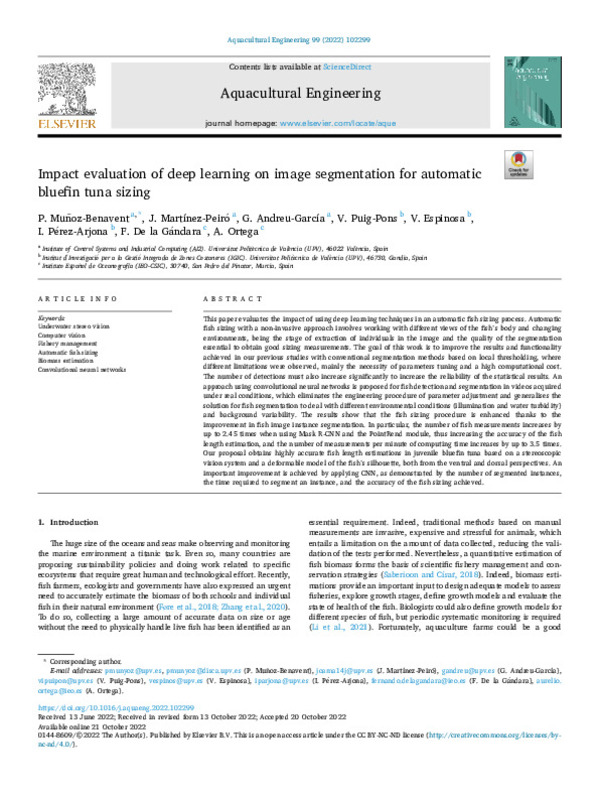Muñoz-Benavent, P.; Martínez-Peiró, J.; Andreu García, G.; Puig Pons, V.; Espinosa Roselló, V.; Pérez Arjona, I.; De La Gándara, F.... (2022). Impact evaluation of deep learning on image segmentation for automatic bluefin tuna sizing. Aquacultural Engineering. 99:1-10. https://doi.org/10.1016/j.aquaeng.2022.102299
Por favor, use este identificador para citar o enlazar este ítem: http://hdl.handle.net/10251/199578
|
Título:
|
Impact evaluation of deep learning on image segmentation for automatic bluefin tuna sizing
|
|
Autor:
|
 Muñoz-Benavent, Pau
Muñoz-Benavent, Pau

 Martínez-Peiró, J.
Martínez-Peiró, J.

 Andreu García, Gabriela
Andreu García, Gabriela

 Puig Pons, Vicente
Puig Pons, Vicente

 Espinosa Roselló, Víctor
Espinosa Roselló, Víctor

 Pérez Arjona, Isabel
De la Gándara, F.
Ortega, A.
Pérez Arjona, Isabel
De la Gándara, F.
Ortega, A.
|
|
Entidad UPV:
|
Universitat Politècnica de València. Escola Tècnica Superior d'Enginyeria Informàtica
Universitat Politècnica de València. Instituto de Investigación para la Gestión Integral de Zonas Costeras - Institut d'Investigació per a la Gestió Integral de Zones Costaneres
Universitat Politècnica de València. Escuela Politécnica Superior de Gandia - Escola Politècnica Superior de Gandia
Universitat Politècnica de València. Instituto Universitario de Automática e Informática Industrial - Institut Universitari d'Automàtica i Informàtica Industrial
|
|
Fecha difusión:
|
|
|
Resumen:
|
[EN] This paper evaluates the impact of using deep learning techniques in an automatic fish sizing process. Automatic fish sizing with a non-invasive approach involves working with different views of the fish's body and ...[+]
[EN] This paper evaluates the impact of using deep learning techniques in an automatic fish sizing process. Automatic fish sizing with a non-invasive approach involves working with different views of the fish's body and changing environments, being the stage of extraction of individuals in the image and the quality of the segmentation essential to obtain good sizing measurements. The goal of this work is to improve the results and functionality achieved in our previous studies with conventional segmentation methods based on local thresholding, where different limitations were observed, mainly the necessity of parameters tuning and a high computational cost. The number of detections must also increase significantly to increase the reliability of the statistical results. An approach using convolutional neural networks is proposed for fish detection and segmentation in videos acquired under real conditions, which eliminates the engineering procedure of parameter adjustment and generalises the solution for fish segmentation to deal with different environmental conditions (illumination and water turbidity) and background variability. The results show that the fish sizing procedure is enhanced thanks to the improvement in fish image instance segmentation. In particular, the number of fish measurements increases by up to 2.45 times when using Mask R-CNN and the PointRend module, thus increasing the accuracy of the fish length estimation, and the number of measurements per minute of computing time increases by up to 3.5 times. Our proposal obtains highly accurate fish length estimations in juvenile bluefin tuna based on a stereoscopic vision system and a deformable model of the fish's silhouette, both from the ventral and dorsal perspectives. An important improvement is achieved by applying CNN, as demonstrated by the number of segmented instances, the time required to segment an instance, and the accuracy of the fish sizing achieved.
[-]
|
|
Palabras clave:
|
Underwater stereo vision
,
Computer vision
,
Fishery management
,
Automatic fish sizing
,
Biomass estimation
,
Convolutional neural networks
|
|
Derechos de uso:
|
Reconocimiento - No comercial - Sin obra derivada (by-nc-nd)
|
|
Fuente:
|
Aquacultural Engineering. (issn:
0144-8609
)
|
|
DOI:
|
10.1016/j.aquaeng.2022.102299
|
|
Editorial:
|
Elsevier
|
|
Versión del editor:
|
https://doi.org/10.1016/j.aquaeng.2022.102299
|
|
Código del Proyecto:
|
info:eu-repo/grantAgreement/GV INNOV.UNI.CIENCIA//THINKINAZUL%2F2021%2F007//INTEGRACION DE TECNOLOGIA DIGITAL Y DEEP LEARNING PARA CONTRIBUIR A MODELOS DE PESCA Y ACUICULTURA INTELIGENTES, MEDIANTE PROCESAMIENTO AUTOMÁTICO DE IMAGENES (ACUINTTEC)/
info:eu-repo/grantAgreement/GENERALITAT VALENCIANA//AICO%2F2021%2F016//TECNICAS AVANZADAS DE VXC BASADAS EN DEEP LEARNING Y CNNS PARA LA CARACTERIZACION BIOMETRICA DEL ATUN ROJO/
info:eu-repo/grantAgreement/UPV-VIN//PAID-10-19//Técnicas avanzadas de visión por computador para identificación y seguimiento en entornos
naturales./
info:eu-repo/grantAgreement/GVA//IDIFEDER%2F2018%2F025//SISTEMAS DE FABRICACIÓN INTELIGENTES PARA LA INDUSTRIA 4.0/
info:eu-repo/grantAgreement/MICINN//PRTR-C17.I1/
|
|
Agradecimientos:
|
This study forms part of the ThinkInAzul programme and was supported by MCIN with funding from European Union NextGenerationEU (PRTR-C17. I1) and by Generalitat Valenciana (THINKINAZUL/2021/.007). It was also supported by ...[+]
This study forms part of the ThinkInAzul programme and was supported by MCIN with funding from European Union NextGenerationEU (PRTR-C17. I1) and by Generalitat Valenciana (THINKINAZUL/2021/.007). It was also supported by funding from AICO/2021/016 (Generalitat Valenciana), PAID-10-19 (UPV) and IDIFEDER/2018/025 (EUFEDER Comunitat Valenciana 2014-2020).
[-]
|
|
Tipo:
|
Artículo
|









